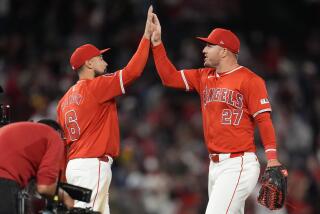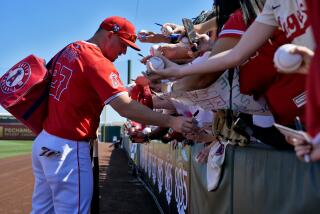Their New Approach Is Better Than Average
The words cause old-timers to cringe and statheads to rejoice. The words reflect a sophisticated new generation of baseball analysis that extends beyond batting averages and home runs. And, in a sport whose lords would have you believe that a team that refuses to spend extravagantly might as well give up, the words help explain the doom-defying success of the low-budget Oakland Athletics.
The words are critical in understanding why the Angels lost miserably last season and whether they might win this season. The words: on-base percentage. The concept is not difficult to grasp, even for those with an aversion to calculation.
“It’s simple math,” Angel center fielder Darin Erstad said. “The more baserunners you have, the more you’ll score.”
Although the Angels are justifiably proud of assembling one of the most impressive starting rotations in franchise history, with veterans Kevin Appier and Aaron Sele joining Jarrod Washburn, Ramon Ortiz and Scott Schoeneweis, all those fine arms are good for nothing more than a .500 season without a revival on offense. The Angels had a pretty good pitching staff last season too, but they lost 87 games, lost sight of the Seattle Mariners in May and limped home 41 games out of first place.
“I think our offense is going to rebound,” Manager Mike Scioscia said. “I’m looking for that as a probability, not a possibility.”
The logic, on the surface: The offense will be better because Erstad and right fielder Tim Salmon can’t possibly play any worse and Brad Fullmer fills the virtual vacancy at designated hitter.
The reality, beneath the surface: That won’t be enough to win if all the Angels don’t do a better job of getting on base and driving runners in.
So, rather than indulging sluggers happy to play bombs away in the thin air of the Cactus League, the Angel coaching staff turned spring training into a six-week clinic in advanced hitting--taking the opposing pitcher deep into the count rather than hacking at the first pitch, taking a walk, moving runners along with an out, getting a runner home from third base with an out
“We’re eliminating batting average,” hitting coach Mickey Hatcher said. “We’re eliminating selfishness.”
Said Erstad: “We’re making a conscious effort to improve, to throw batting average out the window and focus on on-base percentage, runs scored and runners in scoring position. Those are the three indicators of production.”
In the past six seasons, no American League team has advanced to the playoffs while scoring fewer than 800 runs.
The Angels scored 691 last season, joining the Baltimore Orioles and Tampa Bay Devil Rays in the sub-700 club. The Orioles and Devil Rays are as likely to be eliminated via contraction as they are to make the playoffs this season.
The Angels batted .242 with runners in scoring position last season, worst in the league. Their on-base percentage was .327, worst in the division. The top three AL teams in on-base percentage--Seattle, Oakland and the Cleveland Indians--made the playoffs.
“On-base percentage is a big thing,” left fielder Garret Anderson said. “It definitely puts more pressure on the pitcher and the defense.”
On-base percentage measures how often a player reaches base but does not distinguish how he does so--hit, walk or hit by pitch. A .250 hitter with a .400 on-base percentage reaches base four times out of 10, preferable to a .275 hitter with a .300 on-base percentage who reaches base three times out of 10.
In 700 plate appearances--a typical season for an everyday player--the player with the better on-base percentage reaches base 70 times more, extending that many more innings and providing that many more scoring chances.
The more walks, the better the on-base percentage. The more walks--and even two-ball and three-ball counts--the sooner a team can tire out the opposing starting pitcher and pierce the soft underbelly of middle relief.
Under General Manager Billy Beane, the A’s emphasize the acquisition and development of players with high on-base percentages. The Angels have two of the best in Salmon and third baseman Troy Glaus. They also have several of the least patient hitters in the league in Anderson, Fullmer, second baseman Adam Kennedy and catcher Bengie Molina.
“I’m not giving up the first pitch I see. That might be the best pitch I’ll see in that at-bat,” Anderson said. “If a guy throws me a strike, I’m going to swing at it. Taking a strike? I don’t see a purpose in doing it. You only get three. I have a pretty good idea of how to put the ball in play.
“But I’m not as aggressive as I used to be. It hasn’t shown up in my walks, but I’m not swinging at as many bad pitches as I used to.”
Said Erstad: “We have some guys that are first-pitch hitters. That’s fine. Just don’t chase a pitch early in the count. Get a hitter’s count.”
Can veteran major league hitters suddenly develop discipline at the plate? Hatcher says yes, citing six weeks of daily meetings and drills stressing that point as well as the enforcement and reinforcement among players.
“On a winning team, that has to come from the players,” Hatcher said. “These guys have policed themselves very well.... They’ve accepted it. They’re excited about it.”
For what it’s worth, the Cactus League returns were positive. In the final week of the exhibition season, the Angels ranked second in the AL in on-base percentage, second in runs and third in walks. Fullmer and first baseman Scott Spiezio ranked among league leaders in walks; Kennedy and Salmon ranked among leaders in on-base percentage; Erstad and shortstop David Eckstein ranked among leaders in runs.
Take a walk? Take a few pitches? With a runner in scoring position, make an out with a fly ball that moves him up one base?
“I don’t want to hear anybody saying ‘I can’t do it’ or ‘That’s not my game,’” Hatcher said. “That’s not going to happen here anymore.”
More to Read
Go beyond the scoreboard
Get the latest on L.A.'s teams in the daily Sports Report newsletter.
You may occasionally receive promotional content from the Los Angeles Times.






